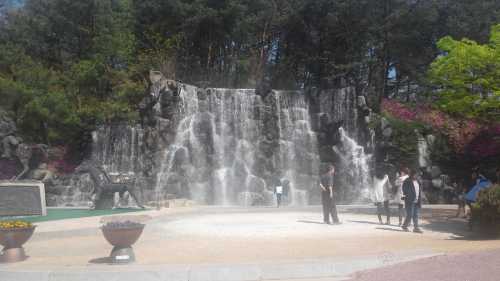Popular Trip Moments
A 2,000-pyeong natural lawn meets a sentimental pool villa🤍 | This is the Insect Ecology Exhibition Hall in Sangju-si, Gyeongsangbuk-do. | This is the Sangju City Cooperative History and Culture Center in Gyeongsangbuk-do. | This is the Hamchang Myeongju Museum in Sangju-si, Gyeongsangbuk-do. | This is the Sangju Hanbok Promotion Center in Gyeongsangbuk-do. | This is the National Nakdong River Biological Resource Center in Sangju-si, Gyeongsangbuk-do. | This is the Sangju Museum in Sangju-si, Gyeongsangbuk-do. | This is the Sangju Agricultural Culture Center in Gyeongsangbuk-do. | Sangju's best restaurants | Sangju Cafe | cafe | Mingju Garden | Gyeongbuk Sangju, Gyeongcheon Island, great for a walk🌿 | What should I do in Sangju? | Recommended cafes with a nice atmosphere in Sangju👍🏻 | Sangju Gyeongcheon University's famous restaurant, Cheongseokgol Restaurant | Beopjusa Palsangjeon with autumn leaves | A trip to Beopjusa Temple | 🏞️ A relaxing place to relax while looking out over the clean natural garden 🏝️ Recommended Hamchang Garden Cafe💚 | Cafe Urim, recommended for its pretty permanent photo zone | Sangju Mungyeong Healing Cafe | Sangju Kongguksu and Suyuk Restaurant, Hyewon Restaurant | Gyeongbuk Sangju Travel Destination Myeongju Garden | Beautiful Autumn View of Malti Mountain Pass | Let's go see the UNESCO World Heritage Site | Is it true that a bowl of noodles costs 3,000 won? | Bicycle City Tour | Hiking course recommended even for beginners | Sangju ‘Nakdong Riverside Multipurpose Plaza’, a popular outdoor camping spot | Sangju Hamchang Saetogong Wang Sundae, Mungyeong Cafe Ramil
Popular Travel Types
Recommended Attractions at Popular Destinations
Bangkok attraction near me | Manila attraction near me | Tokyo attraction near me | Taipei attraction near me | Hong Kong attraction near me | Seoul attraction near me | Kuala Lumpur attraction near me | Los Angeles attraction near me | Shanghai attraction near me | New York attraction near me | Shenzhen attraction near me | Osaka attraction near me | Singapore attraction near me | London attraction near me | Guangzhou attraction near me | San Francisco attraction near me | Beijing attraction near me | Macau attraction near me | Bali attraction near me | Jakarta attraction near me | Paris attraction near me | Ho Chi Minh City attraction near me | Istanbul attraction near me | Phuket attraction near me | Chicago attraction near me | Seattle attraction near me | Toronto attraction near me | Orlando attraction near me | Cebu attraction near me | Chiang Mai attraction near me
Popular Restaurants in Sangju-si
Bhc Chicken | Gosubuji | Baeggangjeong | Hanseong Fusion Town | Temachon | 블란도374 | Taste Na Chicken | Yeonliji | 참새방앗간 | Daemyeong Restaurant | Ba Rokeo Seasoned Chicken | Myeongsil Sanggam Korean Beef Meat Eating Restaurant | Obok Yummy House | Bae Yunbak Charcoal Fire Ribs | Eonni Ya | Siru Bong Restaurant | Euddeum Noodles House | Goryeo Street Food | Gyerim Meat Eating Restaurant | Hot Jap | Smile Ya | Pancake Soup Ji | Duul Shabu Noodles Soup | Ya Mu Ya Mu | Busan Seafood | Gyeongil Meat Eating Restaurant | Palace Meat Eating Restaurant | Seongrim Eel | Geol River Entrails | Bong River Meat Eating Restaurant
Popular Ranked Lists
Popular Trending Restaurants in Singapore | Top 3 Best Things to Do in Chizhou | Popular Best Things to Do in Suifenhe | Popular Trending Restaurants in Tokyo | Popular Premium Hotels Near Douglas County | Popular Best Things to Do in Danba | Popular Luxury Hotels Near Kenmore | Popular Local Restaurants in Wuyi | Popular Best Things to Do in Shangqiu | Top 4 Best Things to Do in Yingkou | Popular Best Things to Do in Luoping | Popular Luxury Hotels in Malargue | Popular Premium Hotels in Phuc Yen | Top 3 Best Things to Do in Zaozhuang | Popular Local Restaurants in Pinghu | Top 4 Local Restaurants in Xiuwu | Popular Trending Restaurants in Shanghai | Top 18 Local Restaurants in Da Nang | Top 4 Best Things to Do in Guigang | Popular Luxury Hotels Near Sandakan Division | Top 10 Local Restaurants in Hat Yai | Popular Best Things to Do in Xinchang | Popular Luxury Hotels in Paradise Island | Popular Premium Hotels in En Gev | Top 16 Local Restaurants in Ningde | Top 9 Local Restaurants in Wushan County | Top 3 Best Things to Do in Linxia Prefecture | Top 18 Local Restaurants in Gold Coast | Top 5 Local Restaurants in Rugao | Top 5 Local Restaurants in Fusong
Payment Methods
Our Partners
Copyright © 2025 Trip.com Travel Singapore Pte. Ltd. All rights reserved
Site Operator: Trip.com Travel Singapore Pte. Ltd.
Site Operator: Trip.com Travel Singapore Pte. Ltd.






















